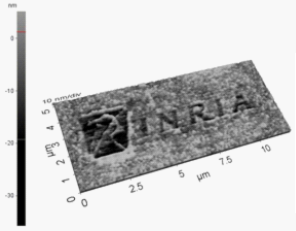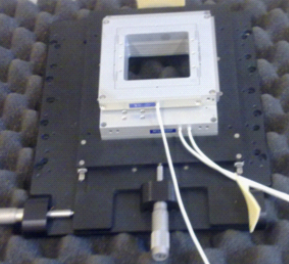Section: Application Domains
Nano/Macro machining
Nano machining
Recent research investigations have reported the development of a number of process chains that are complementary to those used for batch manufacturing of Micro Electro Mechanical Systems (MEMS) and, at the same time, broaden the application domain of products incorporating micro and nano scale features. Such alternative process chains combine micro and nano structuring technologies for master making with replication techniques for high volume production such as injection moulding and roll-to-roll imprinting. In association with the Manufacturing Engineering Center of Cardiff, Arts et Metiers ParisTech center of Lille develops a new process chain for the fabrication of components with nano scale features. In particular, AFM probe-based nano mechanical machining is employed as an alternative master making technology to commonly used lithography-based processes (Fig. ). Previous experimental studies demonstrated the potential of this approach for thermoplastic materials. Such a manufacturing route also represents an attractive prototyping solution to test the functionalities of components with nano scale features prior to their mass fabrication and, thus, to reduce the development time and cost of nano technology-enabled products. Application of our control and estimation techniques improves the trajectory tracking accuracy and the speed of the machining tools.
|
Machining with industrial robots
Industrials are enthusiastic to replace machine-tools with industrial robots: compared to machine-tools, industrial articulated robots are very cheaper, more flexible, and exhibit more important workspaces. They can carry out machining applications like prototyping, cleaning and pre-machining of cast parts, as well as end-machining of middle tolerance parts. Such applications require high accuracy in the positioning and path tracking. Unfortunately, industrial robots have a low stiffness and are not that accurate (Industrial robots were designed to realize repeatable tasks. The robot repeatability ranges typically from 0.03 to 0.1mm, but the accuracy is often measured to be within several millimetres. Due to their serial structure, articulated robot has lower stiffness (less than 1 N / mm) than classical machine-tools (greater than 50 N / mm). These poor accuracy and stiffness are caused by many factors, such as geometric parameter errors (manufacturing tolerances), wear of parts and components replacement, as well as flexibility of links and gear trains, gear backlashes, encoder resolution errors and thermal effects.) and they deserve an increased quality of control. We deal with the modelling and the on-line identification of flexible-joint robot models. This can be used both for dynamic simulation and model-based control of industrial robots. We address the problem of real-time identification of the parameters involved in the dynamic linear model of an industrial robot axis. This is possible thanks to a special sensor developed by Arts et Métiers, subject to an EADS project within the FUI (Fonds Unique Interministériel). Control algorithms for other machining actuators such as active magnet bearings are also under study. Within the framework of LAGIS, we also consider the remote control of industrial robots (via internet of Wi-Fi links, for instance), which sets numerous problems in relation with the communication delays.



